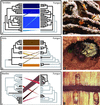Fungus-farming insects: multiple origins and diverse evolutionary histories
- PMID: 12438688
- PMCID: PMC137700
- DOI: 10.1073/pnas.242594799
Fungus-farming insects: multiple origins and diverse evolutionary histories
Figures

Comment on
-
The evolution of fungus-growing termites and their mutualistic fungal symbionts.Proc Natl Acad Sci U S A. 2002 Nov 12;99(23):14887-92. doi: 10.1073/pnas.222313099. Epub 2002 Oct 17. Proc Natl Acad Sci U S A. 2002. PMID: 12386341 Free PMC article.
References
-
- Wilson E. O., (1971) The Insect Societies (Belknap, Cambridge, MA).
-
- Chapela I. H., Rehner, S. A., Schultz, T. R. & Mueller, U. G. (1994) Science 266, 1691-1694. - PubMed
-
- Schultz T. R. & Meier, R. (1995) Syst. Entomol. 20, 337-370.
-
- Mueller U. G., Rehner, S. A. & Schultz, T. R. (1998) Science 281, 2034-2038. - PubMed
Publication types
MeSH terms
Substances
LinkOut - more resources
Full Text Sources
Medical

